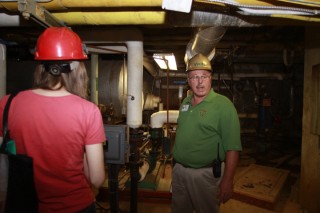
Matt Hellman | Lariat Photographer
By Lela Atwood
Contributor
Unexpectedly during conversations, rumors surface. Whispers of a secret series of underground tunnels that connect every building on campus penetrate the air. Some people insist they exist, while others place the tunnels in the same category as Santa Claus.
But they are real.
In April, a group of three students from the Lariat toured one of these tunnels. The tour guide was Dennis Ferguson, associate director of building services, and Kenneth Halton, manager of the Baylor Energy Complex.
The tour was planned a week in advance due to all the security measures surrounding the facility tunnels since the terrorist attacks of Sept. 11, 2001. The Baylor police and the Waco firefighters were notified of the tour. About three maintenance workers were stationed at various points throughout the tunnel as a safety measure.
Ferguson said it was the first such tour in his 30 years of working at the energy complex. Usually only maintenance workers enter the facility tunnels.
Built in 1952, the facility tunnels gave workers easy access to protected wires and pipes during a time when insulation was shoddy and ineffective.
Through the tunnels run electric lines, water pipes, steam pipes and fiber optic cables.
Brian Nicholson, associate vice president of facilities and construction, said about 13 buildings on campus are connected by these tunnels, which provide hot water and air conditioning.
Clad in clunky hard hats and lab-style goggles, the students descended into the tunnel from the Baylor Energy Complex. Through the dark abyss, small lights shone every 10 feet, with light seeping in from the occasional manhole above.
Workers enter the tunnels through various access points, in hidden doors within the custodian storage areas of buildings, and sometimes use the manholes as emergency exits.
San Antonio senior Kaitlin Speer, who was part of the tour, said the tunnels were similar to how she pictured them.
“It was kind of like you would expect,” Speer said. “But in your imagination, the tunnels would be more scary.”
The group walked in single file, led by Ferguson, taking care not to touch the aging electric wires on the left or the steam pipe on the right situated above the cool water pipe.
Ken Pollard, the executive director of facility services, said that the tunnels are around 6 feet 6 inches tall and around 10 feet wide.
“It’s like walking in a concrete box,” Pollard said.
Yet the facility tunnels are now a tool of the past. Thanks to dramatic upgrades in the quality of insulation, the pipes and electric lines connecting newer buildings on campus are buried.
Walking through the tunnel seemed like an obstacle course, with some pipes obstructing the walkway. Other portions of the dark path were caked with dirt and covered by puddles of slushy mud.
The temperature was about 85 degrees at the time of the tour, but the temperature of the tunnels can be much higher on some occasions.
Nicholson said steam leaves the energy complex at about 315 degrees, and any sort of steam leak could cause severe burns.
“If you and I walked in the tunnel, we would come out drenched in sweat because the temperature is so hot,” Nicholson said. “You wouldn’t want to hang out in these tunnels.”
The tunnel the tour group walked through led to a former bomb shelter directly under North Russell Residence Hall. The area was dingy and dimly lit. The ground was covered with piles of sand almost like a beach. The area was wide enough to hold all of the residents of North Russell and extended as far as the eye could see.
The only evidence that truly betrayed the area’s bomb shelter heritage was a massive collection of U.S. government-issued cylinder bins, which were about the size of a public park trashcan. Instructions on how to use the bins as a water storage unit or as a commode were painted on the side.
The tour concluded as the students climbed up some stairs and exited a door that led into the North Russell courtyard. A few students who were tanning in the courtyard observed the underground visitors with mild curiosity before slipping back into their sunshine daze.
Heavy padlocks, motion sensors that notify police and around-the-clock supervision at the energy complex make trespassing in the tunnels next to impossible. Ferguson said having such advanced measures to protect the underground facilities is vital for a healthy campus.
“The energy complex is the heart of campus,” he said. “And the tunnels are the arteries, so we want to protect them”
In recent months, maintenance trips to the facility tunnels have been more frequent, as workers work to remove the electric lines from the tunnels to bury them in other locations.
Such construction has taken place in the areas across from the Hankamer School of Business, Moody Memorial Library and North Russell.
Nicholson said this move was made to protect the workers.
“If any of the wiring has corrosion, you don’t want workers near that,” he said.
The facility tunnels are not unique to the Baylor campus. Nicholson said many campuses with central energy plants have facility tunnels, too.
Speer said that even though she toured the facility tunnels, much of the tunnels are still shrouded in mystery.
“There’s still a mystique,” Speer said. “We didn’t get to go through all of it.”






